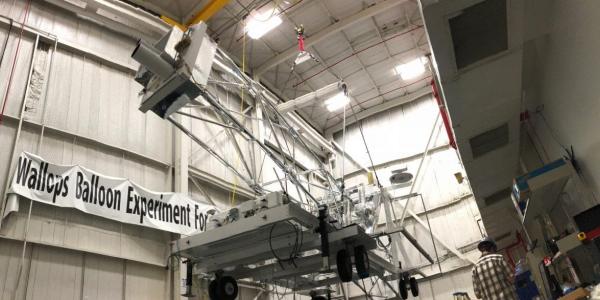It’s going to be a sunny, cold summer this December for scientists headed to Antarctica. McMurdo Station, the continent’s bustling metropolis of roughly 1,000 residents, will be home to researchers hoping to understand more about some of the most exotic phenomena in the universe – neutron stars and black holes. Within this group of researchers is a team from Washington University led by Henric Krawczynski, professor of physics. Krawczynski’s team has built a telescope called X-Calibur to study X-ray binaries, systems where neutron stars and black holes each orbit a star.
Discovered by scientists in the late 20th century, these systems are so energetic that they emit a substantial portion of their radiation as X-rays, the same radiation powerful enough to penetrate our skin. Through the eyes of a telescope that sees only in these energies, the skies are illuminated with X-ray binaries. X-Calibur is just this kind of telescope – specifically it is an X-ray polarimeter, designed to measure the polarization or, roughly, orientations of incoming X-rays.
Other methods of detecting X-rays have shed light on the distribution of X-ray binaries, their chemical composition, and how they change in time. X-Calibur could go even further. Apart from using spectroscopy to discover the elements that make up the systems, scientists can look at the polarization of X-rays to learn more about one of the most fundamental properties of black holes: their spin values.

“The most important thing is that we want to measure black hole spins better,” said Krawczynski. “For supermassive black holes, good spin measurements give information about when and how they form and grow.” When black holes spin, they bend space-time and test one of the most important theories in modern physics, general relativity. Measuring black hole spin values more accurately has the potential to break down general relativity, necessitating new theories.
Another avenue the team will explore involves the systems’ geometry and magnetic fields. These details are in doubt because of the intense environment that surrounds neutron stars and black holes. Their incredible density and gravitational forces cause them to constantly accrete material from their companion star at extremely high energies, in physical conditions unlike anything we have ever experienced here on Earth. Every particle moves very fast, accelerating, and thus generating intense magnetic fields. This extreme environment is difficult to recreate in the lab, so, for now, only pen-to-paper theory can get close to understanding how these systems look and behave. It is the research group’s hope that X-Calibur will shed light on the geometry of these systems. If the team can discover their true geometry, years of theorizing and modeling could come to a close with definitive knowledge.

Fabian Kislat, a recent transplant from the WashU physics department to a professorship at the University of New Hampshire, is hopeful that this mission could yield new insights into hard, or high-energy, X-rays. “If the measurement is really significant, that will really be a first for hard X-ray polarimetry,” Kislat said. X-ray polarimetry is a relatively new field as well, since decades of research have led to less cumbersome polarimeters that fit more easily onto payloads. The Imaging X-Ray Polarimetry Explorer (IXPE), a NASA mission set to launch in 2021, is one of the most prominent, highly refined polarimeters. X-Calibur’s launch will begin to pave the way for this new method of exploration.
Krawczynski’s research group has been refining the essential components of X-Calibur – the polarimeter and the 8-meter-long truss – since its first flight in 2013. This upcoming flight will be the group’s fourth, and hopefully most fruitful, attempt at flying. After two attempts with a faulty pointer system and one successful but brief one-day flight in 2016, this upcoming flight will last for up to a few weeks, potentially gathering a wealth of X-ray data.
For this new project the team has made some adjustments to both the construction and programming of the instrument. Quin Abarr, a fourth-year PhD student in the research group, developed a system to verify that the mirror on one end of the telescope reflected X-rays perfectly onto the detector at the other side. Any slight angle deviation would throw off the entire mission.
Kislat notes that although no major components of the telescope have changed, major updates to the hardware and software have taken place to reduce the amount of noise. Paul Dowkontt, an electrical engineer in the physics department, described this updating process: “We had few prior experiments to look at for guidance. Because of this there was a steep learning curve we had to face.” The team had to constantly work to reduce the amount of noise that could disrupt the data by stabilizing the truss of the telescope and refining the ultra-sensitive chips that would digitize the data.
For Krawcyznski, the uncertainties inherent to flying the telescope are the most concerning parts of the expedition. Blog posts from the 2016 flight detail many uncontrollable factors such as wind and rain conditions that must be just right in order for the telescope to launch. Further complicating X-Calibur’s launch, another WashU physics department research group must launch another telescope, SuperTIGER, successfully in order for X-Calibur to begin launch procedures.
Although these risks loom large, the team is optimistic. “After two years of hard work, the detector now works beautifully,” Kislat said. “Together with the fact that we will have a longer observation time, this makes me very optimistic that the flight will be a success.”





